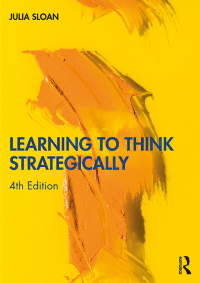
Learning to Think Strategically PDF
Preview Learning to Think Strategically
Cover Page: i Half Title Page: iii Title Page: v Copyright Page: vi Contents Page: vii List of figures, tables, and boxes Page: xi About the author Page: xiii Preface Page: xv Acknowledgments Page: xix Introduction Page: 1 Organization of the book Page: 3 Part I: How did we get here? Strategy: a snapshot Page: 5 1 Chronology of strategy Page: 7 Ancient Greek concept of strategy Page: 8 Military influence on strategy Page: 9 Twentieth-century corporate strategy Page: 11 Strategy and the academy Page: 13 Strategy and consultancies Page: 15 Shift in corporate strategy role Page: 16 2 Contemporary competing views of strategy Page: 19 Technical rational influence Page: 19 Emergent theory influence Page: 21 Comparative discussion Page: 22 Complexity theory Page: 23 Chaos theory Page: 24 Implications of the history of strategy Page: 26 Strategic planning and strategic thinking: two sides of the coin Page: 28 3 Global sketches of strategy Page: 31 Three legendary strategists from across the globe and across the ages Page: 32 Culture’s influence on strategic thinking Page: 34 Modern strategic dilemmas Page: 36 Part I: Summary and questions Page: 41 Part II: How do we learn to think strategically? Formal learning takes a backseat to informal learning Page: 45 4 What is strategic thinking? Page: 47 Cognitive Clusters for Strategic Thinking and Strategic Planning™ Page: 48 The Sloan Triad Model of Strategy™ Page: 50 5 Informal and formal learning defined Page: 55 Informal learning Page: 56 Incidental and intentional learning Page: 57 Formal learning refuted Page: 59 6 Context and learning transfer as factors in the strategic thinking process Page: 65 Metaphor as a learning transfer mechanism Page: 66 7 Three-stage model for learning strategic thinking Page: 75 Preparation stage Page: 75 Experience stage Page: 81 Reevaluation stage Page: 88 Role of reflection in the three-stage informal learning process Page: 90 Part II: Summary and questions Page: 93 Part III: How do we get started? Build a foundation Page: 97 8 Framing as a structural process Page: 99 Framing Page: 99 Shifting and shattering frames Page: 103 Critical reflection as a tool for shifting and shattering frames Page: 104 Reframing Page: 106 Six framing traps that impede reframing Page: 108 The double-edged sword: experience and expertise Page: 109 9 Learning domains used for strategic thinking Page: 113 Data, information, and knowledge Page: 114 Three predecessors of the surf and dive learning domains Page: 116 The surf and dive learning domains Page: 119 Transformative learning Page: 125 Content, process, and premise reflection Page: 127 Part III: Summary and questions Page: 131 Part IV: How do we test the foundation? Critical dialogue and critical inquiry as essential parts of learning to think strategically Page: 135 10 Role of critical dialogue in the strategic thinking process Page: 137 Three factors of a good strategic thinking dialogue Page: 138 Comparison: critical dialogue, discussion, and debate Page: 144 Learning to dialogue Page: 148 11 Role of critical inquiry in the strategic thinking process Page: 153 Good questions Page: 155 Critical dialogue in the three-stage learning process Page: 156 Seven dimensions that benefit from critical inquiry Page: 159 Part IV: Summary and questions Page: 163 Part V: How do we “know” this? Intuition as an outgrowth of experience Strange bedfellows: intuition and analysis as partners in the strategic learning process Page: 165 12 Intuition as a must-have for learning to think strategically Page: 167 Tacit knowledge Page: 170 The intuition factor and framing Page: 173 Noticing “red flags” Page: 177 Challenging through reflection in action and reflection on action Page: 179 The element of surprise Page: 181 13 The roles of analysis and intuition in strategic decision making Page: 185 Intuition as a check on analysis Page: 187 Analysis as a check on intuition Page: 188 Decision-making approaches to strategic thinking Page: 189 Coordinating intuition and analysis Page: 192 Part V: Summary and questions Page: 195 Part VI: What role does culture play? You’d be surprised: culture as a factor for learning to think strategically Page: 197 14 The role of culture on strategic thinking Page: 199 Culture’s impact on pattern recognition Page: 200 Typical faux pas Page: 202 Cross-cultural dimensions impact frames Page: 202 Challenges of introducing strategic thinking across cultures Page: 206 Shattering and reframing across cultures Page: 208 Everyone can learn to think more strategically Page: 209 15 Debunking the myth of the chosen few: five attributes Page: 213 Imagination Page: 216 Broad perspective Page: 218 Juggle Page: 220 No control over Page: 222 Desire to win Page: 224 Interplay of the five attributes Page: 226 Storytelling as a technique for attributes integration Page: 227 Part VI: Summary and questions Page: 231 Part VII: How to become a stronger strategic thinker? Engage in the arts Page: 233 16 Strengthen strategic thinking through the arts Page: 235 Advantages of engaging in the arts Page: 235 Arts support the five attributes Page: 238 Critical reflective processes strengthen the five attributes Page: 241 17 Three unconventional approaches that support learning to think strategically Page: 245 AND polarity thinking Page: 245 Metaphor Page: 249 Drawing Page: 252 Three conventional learning processes Page: 256 Adaptation – a strategic expectation Page: 259 Part VII: Summary and questions Page: 267 Part VIII: Where do we go from here? Suggestions for learning to think strategically Page: 271 18 Where we’ve come from and where we can go: some suggestions Page: 273 Suggestions for individuals Page: 273 Suggestions for learning facilitators Page: 274 Suggestions for business school curricula Page: 277 Suggestions for organizations Page: 279 A “cheat sheet” for individuals and organizations Page: 281 Part VIII: Summary and questions Page: 285 Final summary Page: 287 Bibliography Page: 289 Index Page: 301
Description: